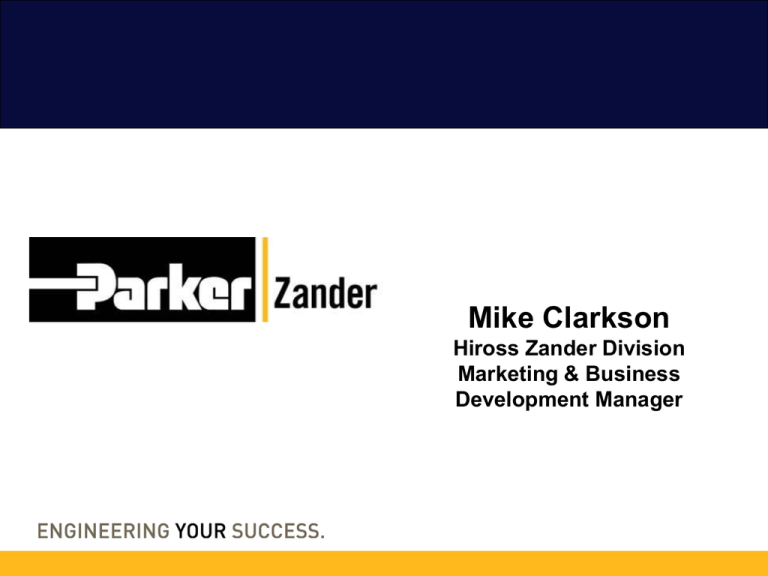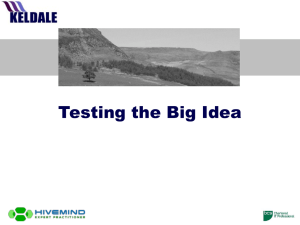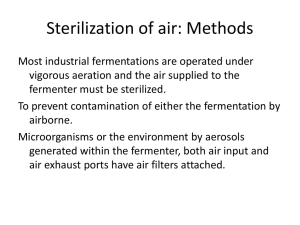Parker Zander “GL
advertisement

Mike Clarkson Hiross Zander Division Marketing & Business Development Manager Attention: Contamination! April 8, 2015 Particulate Particle contamination in a compressed air system comprises Atmospheric dirt, micro-organisms, rust and condensate deposits Much of the contamination is less than 40 millionth of a meter in size (40 micron) and thus remains hidden from the human eye. 3 Water 4 Oil 5 Why use microfilters? Compressing the problem! Compressor Compressor After-Cooler Compressing the contamination Remaining oil content after compressor plus Condensate Compressed Air plus Atmospheric Contamination. Particulate and Humidity. Expansion of the Compressed air Particulate and humidity from the atmosphere. 6 Oil Condensate The new “GL-Technology”: Lowest energy requirement at highest validated performance! April 8, 2015 Why are we replacing the Zander “GSeries” with the “GL-Series?” • New international standards (ISO12500-1) (increased demands on performance) • Competitor activity (Filter element business at risk!) • Innovation (maintaining marketleadership) • A new “Marketing-Story “ 8 Zander “GL-Filter series” Development goals April 8, 2015 What did we want to achieve in the development of a new compressed air filter range? • The highest, validated compressed air quality • Optimum flow characteristics (energy-loss kept to a minimum) • A reduction in the operating costs in comparison with the existing range • Secure the replacement element business. Remove the threat of pirate copies or at least make copying unaffordable • Maintain the key features of the Zander “G-Series” (Taking account of the customer survey ) 10 Input from Customer Survey • • • 11 World-wide scope of approvals All vendors located in Europe, all drawings owned by Zander BSP-P connections – Improvement on Parker dh Evolution filter range Input from Customer Survey • 12 Larger connections sizes – better match to compressor flows and lower delta p Input from Customer Survey • • 13 Pressure gauges optional, all types still available Drain connection via ½“ - free flow of liquid Input from Customer Survey • • • • 14 No extended servicing space necessary below the bowl One flow direction: inside-out Inlet marking on the filter head – clear orientation No over-tightening of housing thread Input from Customer Survey • • • 15 ISO 12500-1 performance for standardised oil-loading – catch- up with Parker domnick hunter Division, Donaldson/Ultrafilter, and Hankison Outer sock - higher oil loading possible Captive element design – protection against pirates Customer Survey - Crucial Points • Third party ISO-performance certificates • Variances to assembly dimensions of series G Cross Port Dims 16 Ref Head Size Port Size G02 G03 G05 G07 G09 G11 G12 G13 G14 G17 G18 G19 1 1/4" 3/8" 1/2" 3/4" 1" 1 1/2" 1 1/2" 2" 2 1/2" 2 1/2" 3" 3" 2 3 4 5 Proposed 67 89 89 89 130 130 164 164 164 192 192 192 Mounting Hole Ctrs Existing Proposed 61 87 87 87 130 130 130 130 164 164 250 250 Red cells highlight values different from the existing product 42 62 62 62 84 84 121 121 121 140 140 140 Existing 34 46 46 46 82 82 82 82 N/A N/A N/A N/A Customer Survey – Cont. 17 Customer Survey – Cont. 18 Customer Survey – Cont. 19 Customer Survey – Cont. 20 Customer Survey – Cont. 21 Parker Zander “GL-Filter series Improvement in flow characteristics – Air Flow Management April 8, 2015 Improving the air inlet to the filter element 23 • Where air flows across a sharp edge, turbulence can occur. This leads to increased resistance to flow and an insufficient distribution of the air flow. • The current filter element design, also true of Zander The air entering the element is directed through a sharp 90° angle. Turbulence, pressure drop, insufficient distribution of the air throughout the filter media is the result. Such rapid changes in direction lead to turbulent flow, system pressure drop and increased running costs. Improving the air inlet to the filter element • 24 Improvement – rounded corners reduce turbulence. The air flow however still doesn`t flow into the element in an even manner. Improving the air inlet to the filter element – Aerospace Technology! 25 • Optimum solution – The addition of deflector-vanes in the air-inlet and a conical air dispenser at the base of the element prevent turbulence by maintaining an even flow distribution at a minimum pressure drop. • Hard to believe, but its true! Compare a conventional 90° angle and the savings of up to 75% to be gained from turbulence-free flow The optimum combination • 26 Deflector-vanes direct the air flow in an unrestricted even-manner into the filter element. Parker Zander “GL-Filter series” Filter element construction - Inlet-/Outlet April 8, 2015 Air inlet – Do away with energy-killers: Conical “full-flow” filter housing inlet • Free-flow, turbulence-free transition of the air entering the filter element. No knife-edges. • The inlet channel to the filter element (top end-cap) matches the inlet diameter of the filter housing. • The top end-cap seals with the aid of two o-rings, above and below the opening. 28 Air inlet – “Its plain sailing”: Flow disribution 29 • “its plain sailing”: Airospace deflector-vanes enable the air to flow evenly into the filter element. • “Go with the flow” - Optimum air distribution throughout the entire filter element with the aid of a flow distributor protruding into the heart of the element. This unique construction ensures full utilisation of the entire surface area. No impact on the base of the element! • 30 A conical soft-air disperser at the base of the filter element prevents turbulence and directs the flow out through the filter media in an even manner. A “successful escape!” • 31 External air stabilisers, located on the filter element top end-cap ensure the even flow of compressed air exiting the filter housing. Parker Zander “GL-Filter series” Filter Media April 8, 2015 The Filter Media – Nano-Technology! • High-efficiency filter media manufactured from borosilicate nanofibres with a voids volume of 96%. • A special “oleophobe” coating is applied to the filter media to actively repel oil and water. • What is nano-technology? Nano comes from the Greek word “nanos”, meaning dwarf. 1 Nano = 1m/1.000.000.000. Nano technology is a particular desigb in atomic and molecular dimensions. Nano technology is not a new product, but a manufacturing technology! 33 Parker Zander incorporates borosilicate nano-fibre technology into it´s current range of filters and into the new GL-filter generation. We termed this material „borosilicate microfibre“ in the past. The change in name is indicative for the development in analytical methods which make it possible to establish the presence of nano-fibres in the material previously refered to as micro-fibre. As the technology exists to proove the presence of such fibres, we now term this filter media „Nano-fibre.“ Large area – greater outcome! • Deep-bed pleating techniques result in 4,5 times more effective filtration area than conventional filter elements – resulting in increased particulate retention, reduced space and lower operating costs Pleated construction Zander G-Series 34 Wrapped construction still seen in many filter elements in the market (dh & Zander in the past) Oil-repelling filter media • 35 The filter media actively repels oil and water (oleophobic coating) Large area – greater outcome! • • The surface area of the filter media has been optimised using deep-pleat technology. A pioneering manufacturing process representing considerable technological advancement. No “glued seam” – now replaced by ultra-sound welding. In contrast, a filterelement from the competition Quelle: http://www.ultrafilter-elemente.ch/ 36 Parker Zander “GL-Filter series” Why change a winning concept? April 8, 2015 Compressed air must not only be clean, but also efficient! As well as the removal of contamination, the economics of using compressed air filters plays an important role. Here the requirement is one of minimising costs and achieving a balance between the compressed air quality being sought and the amount of energy necessary to achieve it. The international standard for compressed air quality provides a simple, clear system for the classification of the three main sources of contamination, namely, water, oil and particulate. 38 Quality requirements - ISO 8573.1 Previous specification QUALITY CLASS 1 2 3 4 DIRT CONCENTRATION Particle size in micron mg/m³ 0,1 0,1 1 1 5 5 15 NOT DEFINED IS0 8573 : 1991, Part 1 for particle contamination 39 In the 1991 edition, the specification states a maximum particle size and a concentration. The 2001 edition however states a maximum quantity of particles per cubic-meter. In order to appreciate the increase in the demand made on air quality between these dates, the 1991 particle concentration csn be converted into the particle quantity. Quality requirements - ISO 8573.1 QUALITY CLASS 1 2 3 4 EDITION 2001, "X-TIMES" CLEANER THAN IN EDITION 1991 0,1 - 0,5 Micron 1,9 Billion times cleaner than class 1 in 1991 19.000 times cleaner than class 2 in 1991 7.000 times cleaner than class 3 in 1991 This technique shows how much cleaner the 2001 classification is, compared with 1991. In accordance with this statement, class 1 in the 1991 edition became class 2. In accordance with the 2001 edition it was only possible to achieve class 1 with a sterile air filter! 40 Quality Requirements - ISO 8573.1:2010 Compressed air quality in accordance with class 1 for particulate means: Per m³ of compressed air, the particle quantity should not exceed 20.000 particle in the size range 0,1 to 0,5. (400 particles in the size range 0,5 to 1 micron and 10 particles in the size range 1 to 5 microns). Particulate ISO 8573.1:2010 The new edition of ISO 8573.1 establishes considerable higher limits for particulate contamination. At first glance, this looks like a worstening of the recommended purity classes! Classification Industrial end-users will profit from the new edition of ISO 8573.1. It establishes more realistically achievable values. It is however advisable to agree which edition of ISO 8573.1 is being referred to when agreements are being made! 41 Wet Particles Dry Particles 1 Parker Zander GL_Z & GL_X Filters Parker Zander GL_Z & GL_X Filters 2 Parker Zander GL_Z Filters Parker Zander GL_Z Filters 3 Parker Zander GL_Z Filters Parker Zander GL_Z Filters 4 Parker Zander GL_Z Filters Parker Zander GL_Z Filters 5 Parker Zander GL_Z Filters Parker Zander GL_Z Filters Proof of performance: The bar is high – but we´re raising it higher! Quality class performance in terms of oil contamination, in accordance with ISO 8573.1 makes no statement regarding the up-stream oil loading entering the filter to arrive at the downstream performance levels required by the norm. For a few years now (since 2007), an international specification governs the inlet oil loading to be achieved and the test equipment to be adopted, to validate the performance of compressed air filters in terms of their stated downstream remaining oil content results. Test methods in accordance with ISO 12500 – Finally a clear statement! 42 Proof of performance: The bar is high – but we´re raising it higher! A standardised statement regarding the inlet oil loading exists since 2007. A basis has been established against which measurements can be made and validation undertaken. Source: Brochure: Donalson Ultrafilter Donaldson Filter 0320 Filter Grade V-Filter S-Filter 43 Flow Rate m³/h 320 320 Differencial pressure Measured Inlet oil Brochure value Differential pressure concentration Dry mbar Saturated mbar Dry mbar Saturated mbar mg/m³ 110 130 80 115 93 292 40 10 Remaining oil content brochure value mg/m³ 0,2 0,01 Actual remaining oil content mg/m³ 7,864 0,008 Proof of performance: The bar is high – but we´re raising it higher! Stated remaining oil content values, following a high performance filter are in actual fact limited in their meaningfulness. However, where account is taken of the validated inlet-loading in accordance with ISO 12500-1, it becomes clear in what range high-performance filters really do perform. New GL-Filtration technology delivers what it states and offers you an independent, validated statement of performance in accordance with ISO 12500-1. 44 Parker Zander “GL-Filter series Coalescing principle April 8, 2015 Why filter elements with an external drainage layer? Why an external drainage layer again? The new ISO 12500-1 establishes high levels of separation duty to be performed. With 40 mg of oil inlet concentration, performances of 99,95% are not achievable with filter elements containing a thin internal drainage layer. In 1990 and the years to follow, the internal drainage layer was second to none in comparison with an external „foam sock.“ (compatibility problems, low resistance to pulsation). Furthermore the new „drainage sock“ represents a new material with oleophobic properties. This is no longer comparable with the less stable foam from two decades ago. Since that time materials technology has made considerable improvements in performance and reliability. 46 External drainage „sock“, manufactured from oil and water repelling material 47 • Liquid repelling material achieves excellent drainage results. • Max. operating temperature 80°C where an internal float-drain is installed and 100°C with a manual drain. • Resistent to all mineral and synthetic compressor oils. Old, used compressor oil “No wet feet!” • No “wet-band” formation, no etra turbulent-free zone. Optimum drainage – bottom end-cap shrouded in drainage material. • Traditional filter elements exhibit a wet-band around the base. • 40% more flow through a small filter element where “wet-band” formation is prevented. 48 “No wet feet!” • Cast housing-ribs compress the lower part of the filter element and encourage liquid coalescence via capillary forces. 49 The sum of all features 50 Parker Zander “GL-Filter series” Product variation April 8, 2015 Optimum fit – no „bottle-necks!“ • 52 GL-series filters have nominal inlet & outlet connections, which have been matched to meet those of the most popular compressor flow rates. Mounting two filters of the same size together? • 53 The new GL-series maintains the tried and trusted method of mounting filters together with the aid of a tie-rod. Simple filter element replacement? Clear indication of the filter inlet avoids confusion 54 • Simple maintenance and filter element replacement • Clean filter element replacement! Avoidance of touching the soiled area of the filter element. • Minimum installation height required to remove filter element (no tie-rod connection) • Space-saving design enables the installation of the filter in an area of limited space The sum of all parts • Complete corrosion resistance – alo-chromed housings protected with a tough dry-powder epoxy coating. Alo-chrom treatment avoids Un-treated aluminium corrosion exhibits corrosion 55 Parker Zander “GL-Filter series” Putting on the pressure – but not at all cost! April 8, 2015 Pressure drop costs money! Pressure resistance 57 • In order to maintain the required operating pressure, the resistance to flow, caused by pressure drop must be compensated for by increased compressor performance. • Results: increased energy requirements, premature compressor wear and an increase in overall cost. • Conventional filters build up an average 200mbar pressure drop, over and above their initial pressure drop, during the first year of operation • Differential pressure gauges (Optional) – For the indication of a high, premature differential pressure. Assumption: Cost of electricity - 0,1 €/kWh Compressor end-pressure 8 bar(a) Avoid experiencing unnecessary pressure drop in the first place by refraining from the use of old filter elements! • 58 Every filter element has a limited economic lifetime. The dirtholding removal capacity becomes exhausted and the materials of construction age – the result is an increasing resistance to pressure in the filter. • Comparison: Compare the investment costs of a new filter element to the energy costs necessary to compensate for the resistance to pressure of a dirty filter element. Its worth changing in time! Parker Zander “GL-Filter series” Options April 8, 2015 Optional differencial pressure measurement! 60 Standard float drain and other drain options 61 • Various drains (Float-drain installed as standard.) • 1/2” threaded connection Parker Zander “GL-Filter series” Sales-support documentation April 8, 2015 Sales-support documentation – Brochure and multi-language operating & maintenance manual 63 Parker Zander “GL-Filter series” Technical Data April 8, 2015 Flow Rates 65 Weighs & Dimensions 66 Product Key 67 This is of value to you: A summary of the benefits Investing in compressed air filters to save money can turn out to be a costly mistake. After all, they should serve to enable the stringent regulations for compressed air quality to be met, without creating high pressure drop in the system. The resulting additional expenditure spent on energy considerably increases operating costs. Rely on the merits of the new GLseries – a decision you will not regret. 68 Thank you for your attention! 69








